As the mobile advertising industry in India grows slowly but steadily, Lavin Punjabi, President and CEO, Affinity talks to Samarpita Banerjee about the need to look at mobile as a separate medium, journey of mCanvas in creating high-impact mobile ads and challenges faced by the industry as a whole
As mobile advertising does not get the importance it deserves from marketers in India despite its potential of making high impact, Lavin Punjabi, President and CEO, Affinity feels that brands need to look at mobile as a separate medium instead of bundling it with digital.
According to Punjabi, with the ever-increasing penetration of mobiles into the lives of consumers in India, there is a need for CMOs to realize that consumers are spending more and more time on mobile than on any other medium.
Saying that most brands still try to take the one-size-fits-all approach when it comes to advertising, Punjabi adds that many players have still not been able to grasp the potential of mobile as a platform. “Mobile is considered to be the bastard child of digital. Most brands direct almost 90% of their ad spends to TV, Print or Radio whereas only 10% comes to digital. Out of that, probably 2% comes to mobile. While different creatives are made for the other mediums, for digital on the whole, only one creative is made which is then repurposed all over the place. This is probably happening because mobile is not yet being considered an important platform. However, most of the current generation is spending much more time on their smartphones than on other mediums,” he says.
STORY-TELLING VIA MCANVAS
Affinity, launched in 2006 as a domain parking company, diversified into search and display ad networks in 2008 and 2012 respectively. However, seeing the lack of innovativeness in mobile advertising in the country and anticipating a burgeoning industry, the company launched mCanvas, a user-initiated mobile ad platform which Punjabi describes as “India’s first mobile story-telling platform”, in 2015. A year-and-a-half since its launch, mCanvas’ uptake among marketers has been encouraging, says Punjabi, adding and the platform already has big clients like Vodafone, Idea, ICICI, McDonald’s, Samsung, The Hindu and The Economic Times, among others.
What Affinity does through mCanvas is simple - it tries to make ads appearing on mobile devices more engaging, by adding stories and interactivity. The three core principles the platform works on are - all the ads are user-initiated, full-screen and sensory in nature (using the sensory features of a phone like tap, location or camera). “The aim is to try and prevent users from closing the ad windows by presenting interesting stories through videos, images or even small games in some cases,” Punjabi explains.
THE FOUR CHALLENGES
Talking about the challenges that the mobile ad industry faces, he says, “The industry is plagued by four overbearing challenges. Over 60% of the clicks on ads by consumers are accidental, viewability of ads is under 27%, over 86% of the ads remain unnoticed due to banner blindness and there is an over-arching lack of engaging story-telling in the ads.”
The aim of mCanvas, Punjabi says, was to try to solve these problems by working on consumer insights. “About a year back, we realized that everything being done in the mobile advertising sector in India is plain bad. Our tech-savvy generation that spends a lot of time on young portals like ScoopWhoop and BuzzFeed hate banner ads. They are flat, boring and lack in creativity. Most times, the ads are clicked accidentally. Most of us have a general blindness towards banners,” he observes.
However, looking at the reception the platform has received from brands since its launch, Punjabi feels that things can only look up from here. “The next big trend in the mobile ad industry is going to be the use of videos for maximum impact. But brands need to understand what today’s digital consumer wants. They are doing a lot on social which gives them good reach but they aren’t doing much with the independent publishing community,” he says.
He hopes that brands can spend time producing content for today’s generation. “The important thing for brands to understand is that mobile and digital are not the same. Mobile needs some dedication and focus. It needs its own space, attention, creative, focus area and managers from our generation who understand the platform well,” he states.
@ FEEDBACK
samarpita.banerjee@exchange4media.com























